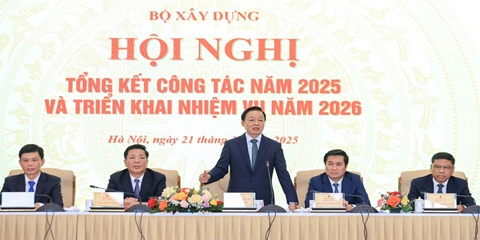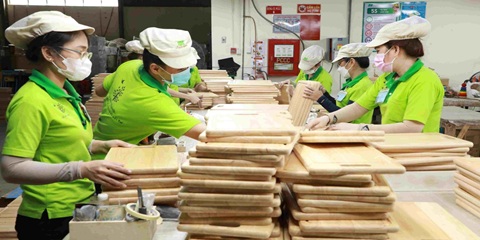Want to be in the loop?
subscribe to
our notification
Business News
TEXTILE-GARMENT EXPORT GROWTH COOLS
VCOSA vice chairman Nguyen Hong Giang said the growth slowed compared to that in previous years and below expectations due to a lack of orders and falling demand on global markets.
If the tough situation continues, it will be hard for the sector to earn US$29 billion in revenue this year, which is even lower the target of US$31 billion set earlier this year, Giang said at a news briefing on Tuesday to introduce the 16th Vietnam International Textile and Garment Industry Exhibition (VTG 2016) slated to take place in November.
The decrease in export orders resulted from mounting competition from rivals including China, India, Cambodia, Bangladesh, Myanmar, and Sri Lanka. In addition, Cambodia and Myanmar enjoy tax incentives when selling textile-garment products to the European Union (EU), making their products even more competitive.
In the past two weeks, a number of textile and garment exporters have had no orders to fulfill, said Pham Xuan Hong, chairman of the HCMC Association of Garment-Textile-Embroidery-Knitting (AGTEK).
Given fierce competition on global markets, Hong suggested firms invest in advanced machinery and equipment, choose high-quality materials to cut production costs and raise the competitiveness of their products, and focus on free-on-board (FOB) contracts.
Besides competition, domestic apparel firms are grappling with difficulties, brought about by the minimum wage rise and regulations on inspections.
Fewer foreign direct investment (FDI) approvals have been registered for the textile and garment industry this year than in previous years.
In 2014 and 2015, many foreign enterprises rushed to invest in the sector to capitalize on opportunities from the Trans-Pacific Partnership (TPP) trade agreement, which allows firms to enjoy tax breaks when exporting products to member states.
But investors are in standby mode in the U.S. election year as it the election result could affect the future of the multilateral trade pact, Giang of VCOSA said.
Hong of AGTEK shared Giang’s view, saying that the implementation of FDI projects in Vietnam’s garment and textile sector may be slower than scheduled as investors would wait for the U.S. presidential election result.
But Giang said Vietnam is still attractive to foreign investors thanks to its free trade agreements with Japan, South Korea and the EU, not to mention the fact that the production cost in Vietnam is cheaper than in many other markets.
Up to many foreign retailers want to choose Vietnam to invest instead of China, Giang said, citing data from the U.S. Fashion Industry Association (USFIA).
Source: The Saigon Times
Related News

A STELLAR CHRISTMAS AT SOFITEL SAIGON PLAZA
Experience the magic of year-end celebrations in five-star luxury, where Parisian elegance meets Saigon’s festive vibrancy. Discover your Stellar Christmas moments: https://sofitel-saigon-plaza.com/festive-offer-2025

CONSTRUCTION SECTOR POSTS OVER 9% GROWTH IN 2025
Industries under the ministry’s management accounted for an estimated 17.23% of national gross domestic product (GDP), up about 0.17 percentage point from 2024. They contributed around 1.96 percentage points to overall GDP growth, reported the Vietnam News Agency. The contribution helped push Vietnam’s economic growth to above 8% in 2025 and supports the Government’s aim of pursuing double-digit growth in the coming years.

VIETNAM PUTS PUBLIC INVESTMENT DISBURSEMENTS AT VND603.6 TRILLION
Vietnam’s public investment disbursements had amounted to VND603.6 trillion in the year to December 18, equivalent to 66.1% of the plan assigned by the prime minister. According to the Ministry of Finance, actual disbursements by December 11 had totaled VND577.7 trillion, or 63.3% of the prime minister-approved plan of VND913.2 trillion, the Vietnam News Agency reported.

SHINE INTO 2026 AT HOIANA RESORT & GOLF!
This New Year’s Eve, celebrate where the sea meets the sky. Vibrant performances, festive dining, DJ beats, live bands and dazzling fireworks come together for one unforgettable night. From beachfront countdown moments to curated New Year’s Eve dinners across Hoiana, every detail is designed to welcome 2026 in style.

VIETNAM’S TRADE SET TO SURPASS US$900 BILLION FOR FIRST TIME
Vietnam’s total import-export turnover is expected to reach about US$920 billion by the end of the year, marking the first time the country’s trade value has exceeded the US$900-billion mark. As of December 15, Vietnam’s total trade turnover stood at US$883.7 billion, according to the Agency of Foreign Trade under the Ministry of Industry and Trade.

GLOBAL SOURCING FAIR VIETNAM 2026 – THE TRULY GLOBAL B2B SOURCING SHOW IN VIETNAM TO EXPAND & DIVERSIFY YOUR EXPORT MARKETS WORLDWIDE
The 4th edition of Global Sourcing Fair Vietnam returns in 2026 with an impressive scale, featuring 700 booths showcasing Fashion & Accessories, Home & Gifts, and the newly introduced Printing & Packaging Products from 500+ verified suppliers across Vietnam and Asia – including Mainland China, Taiwan, Hong Kong SAR, South Korea, India, Bangladesh, ASEAN, and more.
























